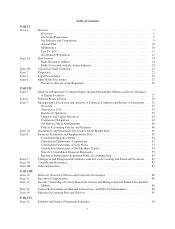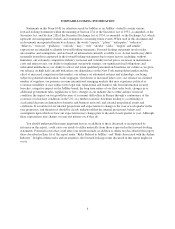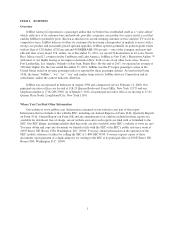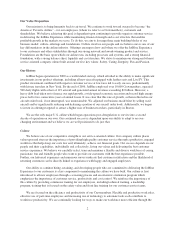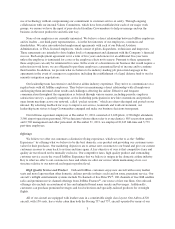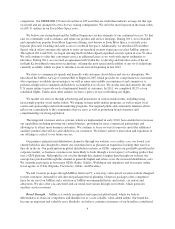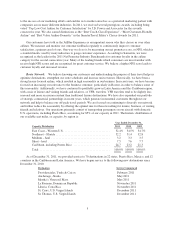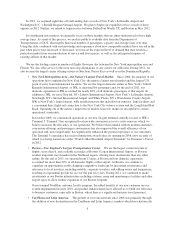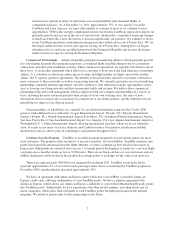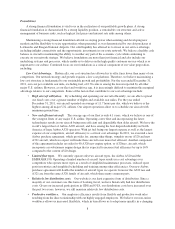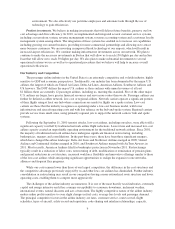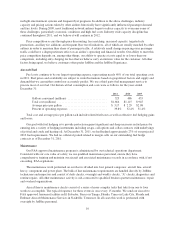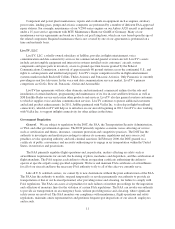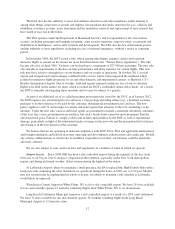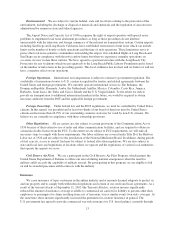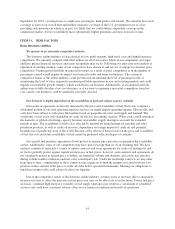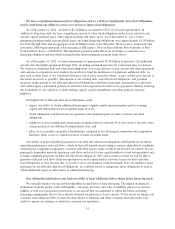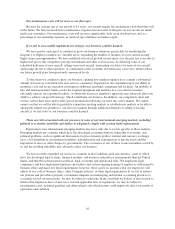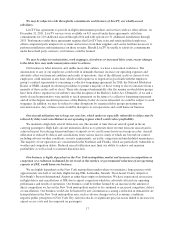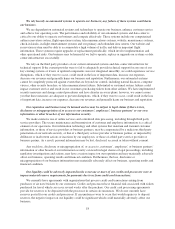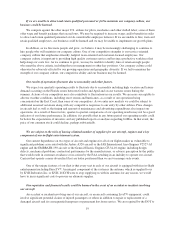JetBlue Airlines 2011 Annual Report Download - page 19
Download and view the complete annual report
Please find page 19 of the 2011 JetBlue Airlines annual report below. You can navigate through the pages in the report by either clicking on the pages listed below, or by using the keyword search tool below to find specific information within the annual report.environment. We also effectively use part-time employees and automate tasks through the use of
technology to gain efficiencies.
Prudent investments. We believe in making investments that will deliver future benefits, preserve our low
cost advantage and drive efficiency. In 2010, we implemented and integrated several customer service systems,
including a reservations system, revenue management system, revenue accounting system and a customer loyalty
management system among others. The integration of these systems has enabled us to increase our capabilities
including growing our current business, providing for more commercial partnerships and allowing us to attract
more business customers. We are investing in improved kiosk technology at our airports, which will result in
increased airport efficiencies. We continue making infrastructure investments across our network. We plan to
continue to make the necessary investments in Boston that will allow us to reach 150 flights per day and in San
Juan that will allow us to reach 50 flights per day. We also plan to make substantial investments to several
operational systems we use as well as to operational procedures that we believe will help to increase overall
operational efficiencies.
Our Industry and Competition
The passenger airline industry in the United States is an extremely competitive and volatile industry, highly
sensitive to GDP and economic perspectives. Traditionally, our industry has been dominated by the major U.S.
airlines, the largest of which are United Air Lines, Delta Air Lines, American Airlines, Southwest Airlines and
US Airways. The DOT defines the major U.S. airlines as those airlines with annual revenues of at least
$1 billion; there are currently 12 passenger airlines, including us, meeting this standard. Five of the other major
U.S. airlines are larger, have greater financial resources and serve more routes than we do. Passenger airlines can
further be defined as either network, low-cost or regional airlines. Network carriers operate a significant portion
of their flights using at least one hub where connections are made for flights on a spoke system. Low-cost
carriers are those that the industry recognizes as operating under a low-cost business model, with lower
infrastructure and aircraft operating costs and with less reliance on the hub-and-spoke system. Regional carriers
provide service from small cities, using primarily regional jets to support the network carriers’ hub and spoke
systems.
Following the September 11, 2001 terrorist attacks, low-cost airlines, including ourselves, were able to fill a
significant capacity void left by traditional network airline flight reductions. Lower fares and increased low-cost
airline capacity created an unprofitable operating environment for the traditional network airlines. Since 2001,
the majority of traditional network airlines have undergone significant financial restructuring, including
bankruptcies, mergers and consolidations. In the past three years, there have been three significant mergers,
which have changed the airline landscape: Delta Air Lines and Northwest Airlines merged in 2009; United
Airlines and Continental Airlines merged in 2010; and Southwest Airlines merged with AirTran Airways in
2011. Most recently, American Airlines filed for bankruptcy protection in November 2011. Restructurings
typically result in a reduction of labor costs, restructuring of debt, modification or termination of pension plans
and general reductions in cost structure, increased workforce flexibility and innovative offerings similar to those
of the low-cost airlines while anticipating significant opportunities to realign the expansive route networks,
alliances and frequent flier programs.
While our costs remain lower than those of our largest competitors, the difference in the cost structures and
the competitive advantage previously enjoyed by us and other low-cost airlines has diminished. Further industry
consolidation or restructuring may result in our competitors having a more rationalized route structure and lower
operating costs, enabling them to compete more aggressively.
The challenges of the airline industry are numerous. It is one of the most heavily taxed industries, extremely
capital and energy intensive and it has a unique susceptibility to economic downturns, inclement weather,
international events, natural disasters and acts of terrorism. The highly competitive nature of the airline industry
makes airline profits sensitive to even slight changes in fuel costs, average fare levels and passenger demand.
The principal competitive factors in the airline industry are fares, customer service, routes served, flight
schedules, types of aircraft, safety record and reputation, code-sharing and interline relationships, capacity,
9


